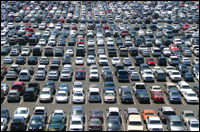To some environmentalists, the shoppers of the world have nothing to lose but their chains. If only people stopped spending at these awful big-box stores, the thinking goes, the earth might be saved — and local businesses would flourish.

Shop to it!
From an environmental perspective, there is in fact much to dislike about the chains. Their low prices, sustained by a rapidly globalizing economy, promote resource-churning consumerism. They are typically reached only by auto, and thus inspire millions of greenhouse-gas-spewing car trips. And surrounded by a sea of parking lots, they are anchors of the sprawling new suburbs many of us love to hate.
But the case against the chains is not nearly so clear-cut — if you’ll pardon the expression in these tree-hugging precincts. My own view is that, from a save-the-earth standpoint at least, shopping at these stores isn’t evil. It may even make the environment better.
Events of Chain
Bear in mind, first of all, that chain stores didn’t only just appear. Sears and Montgomery Ward, to name two, cropped up in the late 19th century. They were innovative and dominating retailers in their heyday, and while today we find the former quaintly harmless (the latter is dead and buried), it’s worth remembering that once upon a time they generated some of the same antagonism that Wal-Mart does — for driving out local merchants, for example. In the 1920s, these mail-order businesses began sprouting brick-and-mortar branches on Main Streets all over America — in the days when people walked and rode transit. Eventually they did follow their customers to suburbia, but their early history shows that it’s possible to be a chain in a world with a set of transportation options and land-use policies quite different from today’s.
Yes, today’s stores are bigger. But the point is, multi-outlet retailers simply aren’t to blame for the car-oriented society in which we find ourselves, and different zoning (to say nothing of different consumer preferences) could produce a very different retailing environment, chain ownership notwithstanding.

Nobody’s asphalt but our own.
Chain retailing, moreover, has environmental advantages. Stores like Wal-Mart and Target offer one-stop shopping for families, surely obviating many car trips. By offering only giant quantities, Sam’s Club minimizes both shopping trips and packaging — it doesn’t even offer grocery bags. If you hate Wal-Mart Stores Inc., Sam’s parent, there is always Costco, which offers many of the same advantages plus higher wages for workers.
Large chains are also easier to monitor — and pressure — than a thousand local lumberyards or toy stores, in part because they are public companies, with all the disclosure and press scrutiny that that entails. Criticism of Wal-Mart clearly has played a role in its much-ballyhooed recent initiatives to improve environmental performance and give more employees health insurance, both arenas where small companies frankly have little to brag about. Note also how central management can rapidly change practices at thousands of stores: Home Depot now is America’s biggest seller of lumber certified by the Forest Stewardship Council, and the company’s size permits elaborate efforts to determine where its wood comes from and how it was harvested. The chain contends that it now knows the provenance of every broomstick and two-by-four on its shelves.
Another environmental knock on the chains is that they supposedly export pollution by selling so much stuff made in places with lax environmental standards (to say nothing of lax labor laws). At the very least, an awful lot of energy is expended moving products around the world to feed the global manufacturing beast. Surely it would be better to buy local.
In fact, for environmental and other reasons, it is much better not to. The main reason is that, ecologically speaking, money really matters. The worst thing for the global environment, aside from so many Americans tooling around in Ford Explorers, is massive poverty. By bringing economies of scale to the distribution of goods and leveraging the differing productive capacities of nations, modern mass merchandisers have found a good way to make the world richer — something mass merchandisers have been doing in America for more than 100 years. The resources expended transporting goods simply pale against the affluence that results. And having money is what enables us to afford a cleaner, healthier environment.
Despite our misgivings, moreover, the chains spread around this wealth. We may not envy workers in developing countries who take factory jobs, but apparently they vastly prefer these to the rural life they are leaving behind in droves. In the short term, the industrialization of those countries may lead to some environmental problems, but in the longer run it’s all to the good. Economists have shown again and again that environmental conditions worsen as a country develops, only to improve again as it grows affluent enough to demand and afford cleaner water and air. It’s possible that someday a country will leap past the dirty stage of development straight to a post-industrial economy, but meanwhile the model we have is better than any known alternative, on both humanitarian and environmental grounds.
“Fears that globalization necessarily hurts the environment are not well-founded,” writes economist Jeffrey A. Frankel of Harvard’s Kennedy School of Government. “A survey reveals little statistical evidence, on average across countries, that openness to international trade undermines national attempts at environmental regulation through a ‘race to the bottom’ effect.”
Low, Low Vices
There are other social and economic arguments about the virtues and vices of chain stores, of course, all of them beyond the scope of this column. But at base, I think, a large factor in our objections to these stores — particularly in the environmental argument against them — is aesthetic. And there’s no denying that looks matter; our love of nature’s beauty is a big reason we care about the environment, after all. Squatting dumbly behind their vast aprons of blacktop, America’s suburban chain stores are as ugly as they are banal, together comprising a built environment that exemplifies Joni Mitchell’s song about paving paradise for a parking lot. And she didn’t even have a verse about runoff.
Perhaps their worst offense, in other words, is that the chains represent such a drastic homogenization and dehumanization of the landscape. Sadly enough, this is the dimension of the chain-store phenomenon that is least likely to change. The simple reason is that the automobile is here to stay, even if the infernal — er, that is, internal — combustion engine is not.
Since the chains aren’t about to vanish, maybe a better strategy is to go ahead and shop there. Estimate your savings each time you go, and then put that money aside. At the end of the year, you should be able to make a pretty nifty donation to the environmental cause of your choice.



